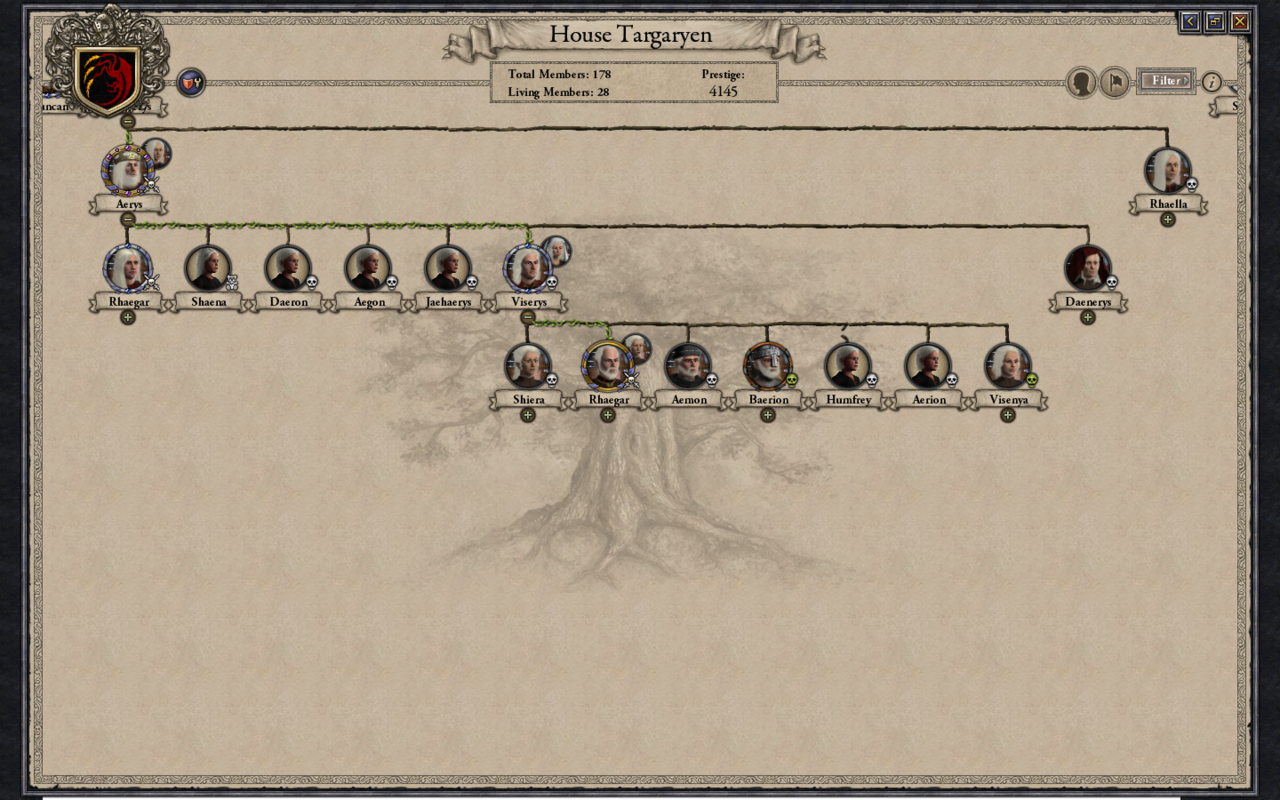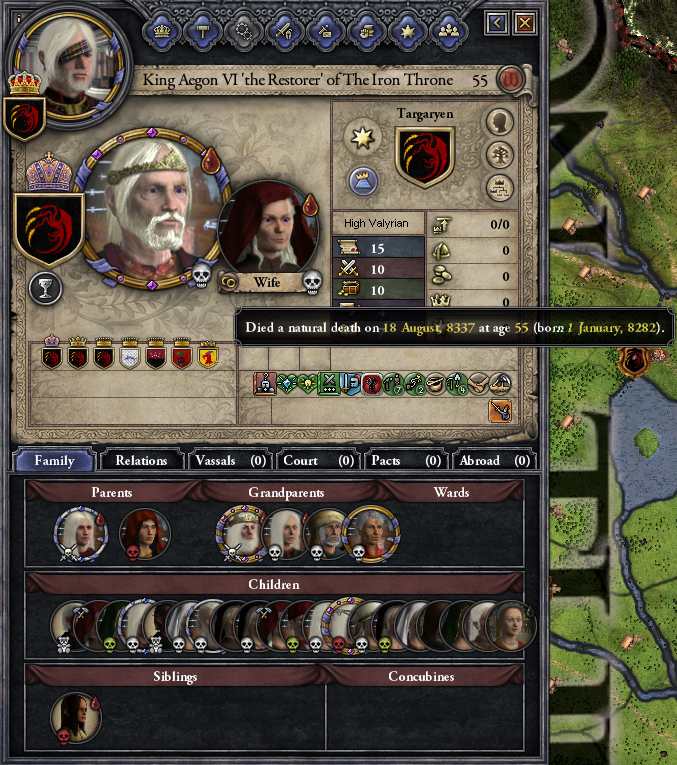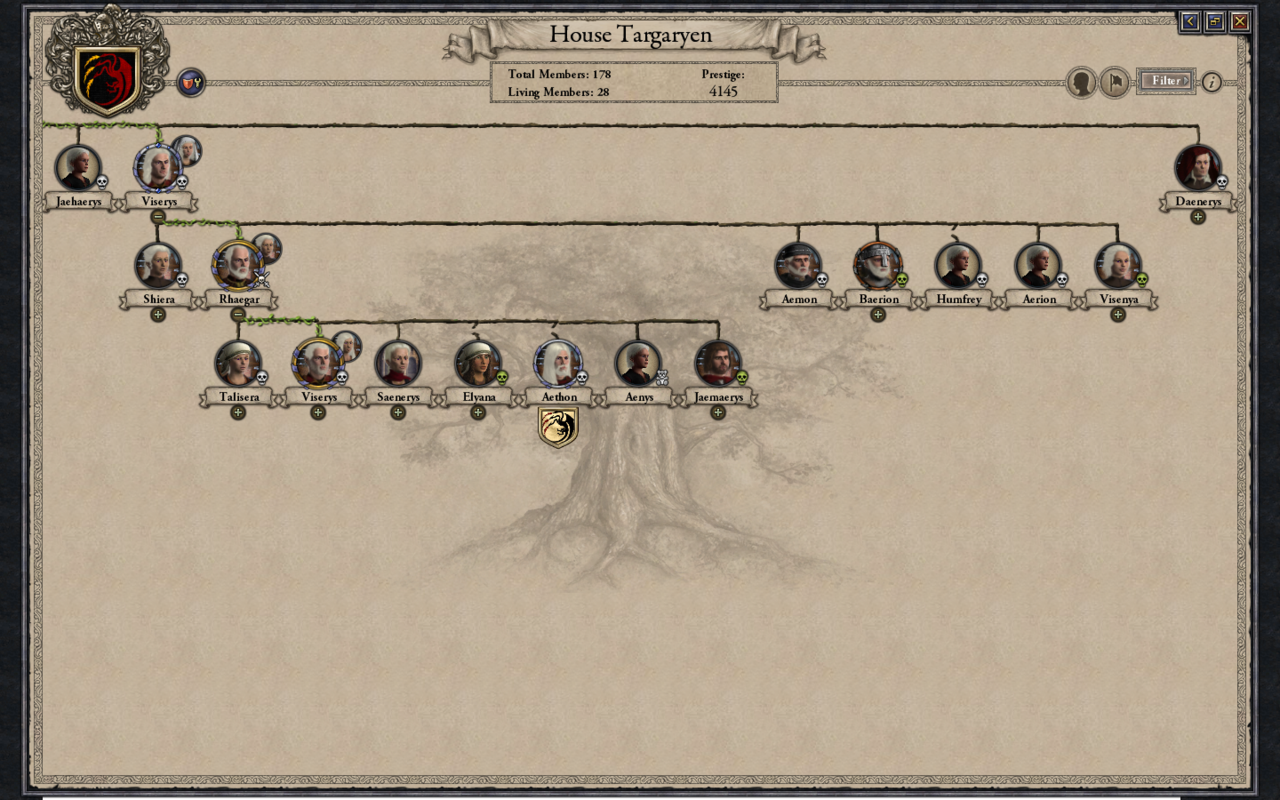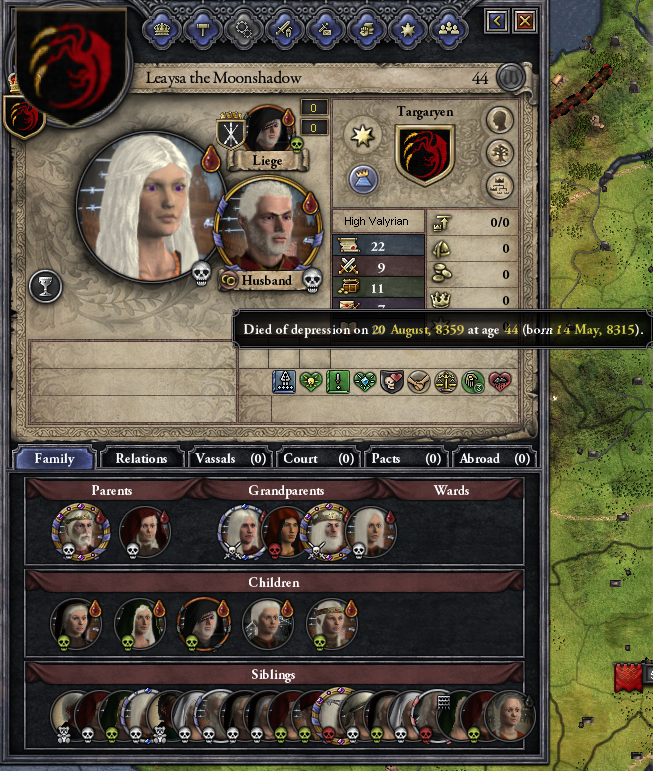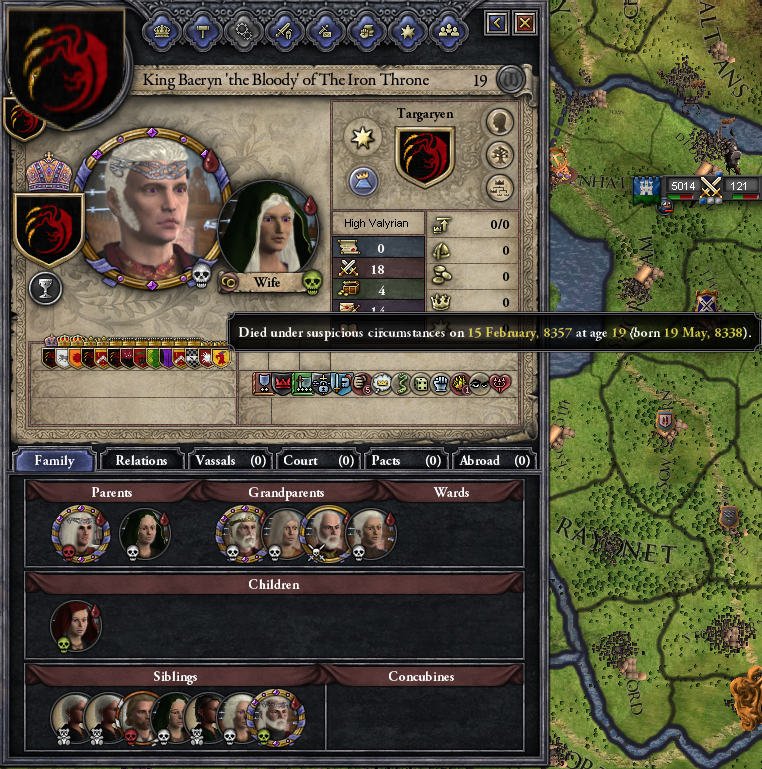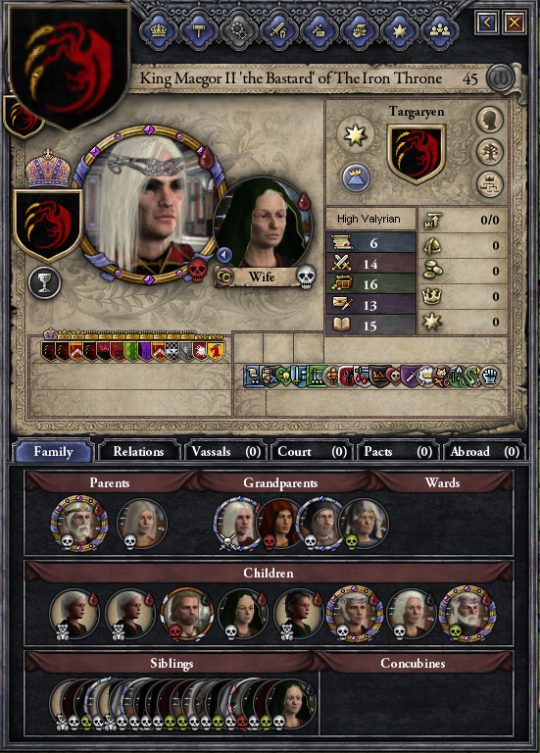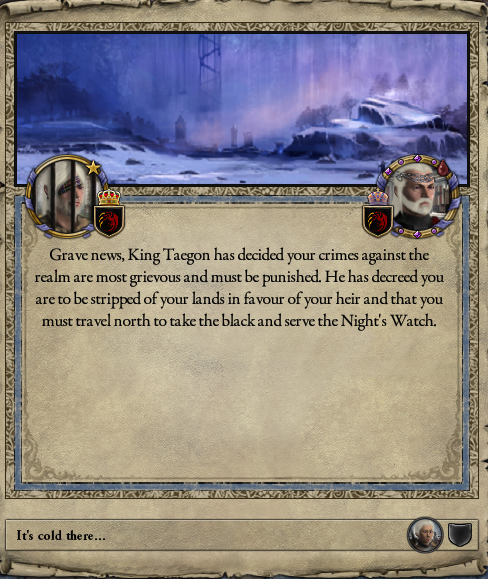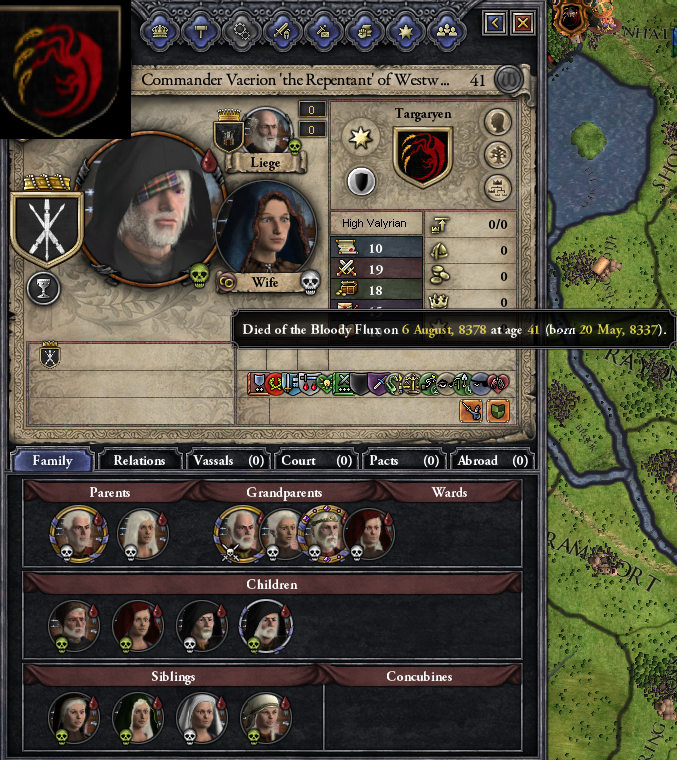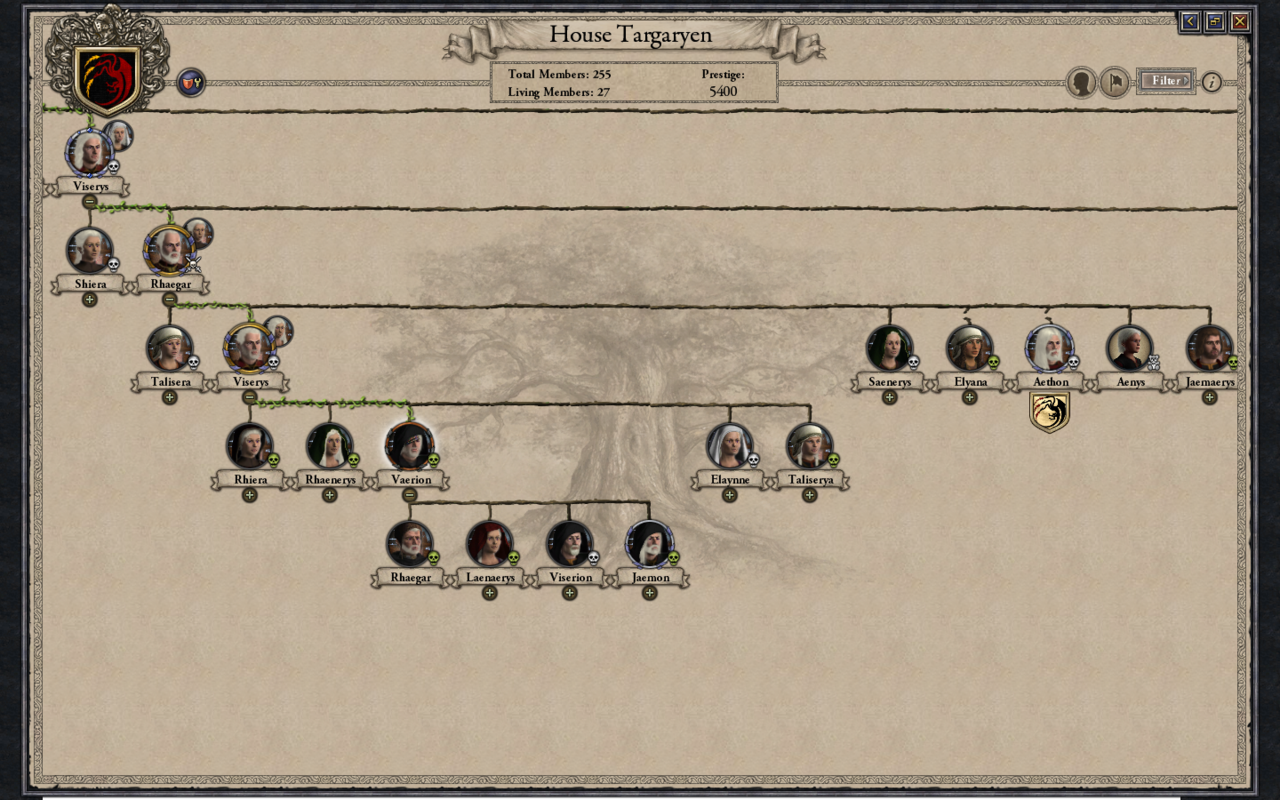Viserys
To record in annals the legacy of kings and conquerors is often regarded to be the highest form of history. We here do not proclaim to give a full account of the lives but focus on the tales and songs that have been born around the Targaryens of Harrenhal, those who did not rule the seven kingdoms, but remained cousin and kin to the many kings that did
Just as these Targaryens rebuilt the ruins of Harren the Black, so too do we strive to rebuild these notable figures from tales of their exploits, accomplishments and downfalls.
The Targaryen restoration started in a position of their greatest weakness, the young escaped prince and princess Viserys and Daenerys in custody of King Robert of House Baratheon (the events that led to this are murky, though we can estimate that they were either ransomed or recaptured from Essos). Yet this disturbance came at a greater unrest for Westeros, with a short-lived Ironborn uprising having taken place not long before and it is said that this recent bloodshed had slaked the Usurper’s appetite for further death and he showed an unprecedented mercy towards the Targaryen siblings.
The lesser threat of the child Daenerys was shipped to her own birthplace of Dragonstone, to be raised by King Robert’s brother (and likely to be wed into a loyal house or to the King’s own heir, Joffery).
The matter of Viserys however, must have been clear to those in King Robert’s court- such a threat to the Iron Throne must be sent to the Wall and live out his days without claim nor children. A harsh sentence to the young boy no doubt, but needless there would have been those who expected exile for the prince, if not outright execution.
But in a move that most likely saved King Robert from the executioner’s sword himself years on, the King granted Viserys high lordship over Harrenhall, as well as the empty seat itself. The reasons for this act are seen as follows
Despite being given Harrenhal, the young prince would not see it until he was grown, as King Robert would not foster him out but instead kept him in Kings Landing under the charge of the Kingsguard, and as the squire of the Lord Commander, Ser Barristan Selmy.
We leave the telling of the exploits of Ser Barristan to the true and detailed accounts, for his interactions with Viserys we cannot say were his greatest feats. But nevertheless, the result of having such a knight as a guardian for the last Targaryen can be felt for generations at Harrenhal. Whatever madness the prince had was soon tempered and from his sword work to his sense of justice Viserys was greatly shaped by the Lord Commander’s guidance and a great friendship grew between them.
This was to be soon tested, however, after the newly-knighted Viserys was at last at Harrenhal and undertaking his duties, including a bloody revenge. With many of the records expunged in the wake of the fall of House Baratheon, what we do know is that Viserys returned to Kings Landing soon enough, as a prisoner. The deaths of Ser Gregor Clegane and Ser Amery Lorch were rumoured as a sworn vengeance on the murderers of Viserys’ beloved older brother’s family. However this is disputed, the claim being it was a plot to murder the Lord Paramount Tywin Lannister that finally allowed King Robert’s Hand to attempt justice.
Having squired and been knighted by Ser Barristan, Prince Viserys was a cunning duelist and would no doubt win blades with any opponent during a Trial by Combat. But his opponent would have been Viserys’s own friend and mentor, Ser Barristan Selmy. With this terrible choice, the consequences being the fall of his own life and the Targaryen house, or the death of his greatest friend at his own steel, we can see the inspiration for the tale of The Bold Knight, the Black Knight.
Two versions of this story exist, with two different endings. The characters are the same with one based on Ser Barristan’s epithet of ’Bold’. As Viserys had not yet earned the nickname he would be known by, we can guess that his descriptor of ‘Black’ is in reference to either his place in the Black Cells, his seat build by Harren the Black or even the black stain of dishonour the tale refers to. Regardless, the more popular and sorrowful story ending has the two knights forced to fight despite being as close as father and son, where the Bold Knight slays the Black Knight and justice is meted out. The real events of the Trial That Never Was made for a less dramatic story ending, as Viserys was some time later returned to Harrenhal unscathed, having assumably organised a bargain or ransom with the coin he’d been repairing Harrenhal with. In the years following, we can add here, he would be joined by his younger sister (now grown and yet to be betrothed) whose visit may have allowed the subsequent war for the Iron Throne to include the force of Harrenhal.
In an event documented by much more thorough maesters, the return of Aegon the Restorer, son of Rhaegar and Elia to claim his rightful throne meant as much to his kin Viserys as it did to their foes. The then eighteen Aegon's claim was supported by Viserys and Daenerys and their current position as no longer hostages to King Robert allowed them to fight alongside their young nephew and at its end, they were there at Aegon's coronation. It is said this is where Prince Viserys, newly second in line to the Iron Throne, offered his beloved sister in marriage to their new king and the reign of the Targaryens King Aegon and Queen Daenerys began once more.
In this changeover, Viserys is referenced again in the Usurper Trials, where Robert Baratheon's mercy to Viserys and Daenerys meant he was not executed or exiled to Essos with his children but instead sent to the Wall where he rose to Lord Commander until his death at a great age. The numerous tales in praise of the fair new King do not mention Prince Viserys much, as he had returned to work on Harrenhal and gain the trust of his new Lord Paramount Edmure Tully as a Master-at-arms in Riverrun.
The Bower Bloom’d, a song ostensibly about Garth Greenhair (or even perhaps the Greenfield’s seat of the Bower) is more commonly linked to Aegon the Restorer and his four lovers- all natural-born daughters of prominent houses.
One such line references the four women’s bastard surnames:
“The King loved each river-stone, he loved each hill and flower
He raised them to his breast and lay them in his bower”
This is in reference to Joy Hill (Lannister), Mya Stone (Baratheon), Alys Flowers (Tyrell) and the famous Ravella Rivers (Frey). Furthermore, the storm which the song mentions the King keeping his ‘bower-bed warm’ from, speaks to Queen Daenerys, Aegon’s wife, called ’Stormborn’, who by all accounts was long-suffering of her husband’s roaming. The Targaryen King was frequently likened to his ancestor Aegon the Unworthy throughout his life, with Queen Daenerys akin to Queen Naerys and so her beloved brother was destined to be known by a glorious and infamous title.
For each whisper that called Viserys 'Aemon the Dragonknight reborn', they fail to take into account the one person that Viserys was known to have loved more than his cherished sister- Talisa, the lady of Harrenhal from the Maegyr house of Volantis. It was she who upon winning his first grand tourney was crowed Viserys's Queen of Love and Beauty and only after her illness and sudden death did Viserys begin to crown his sister with the title instead (passing over his second wife Saenera Paenymion). The curse of Harrenhal had stuck not only Talisa but two of their infant sons and at the age of thirty-seven Viserys himself died. This was attributed to stress, as the loss of his much loved first wife and his friend Ser Barristan fed into Viserys's paranoia in his last years as he worked tirelessly to move the rubble of Harrenhal.
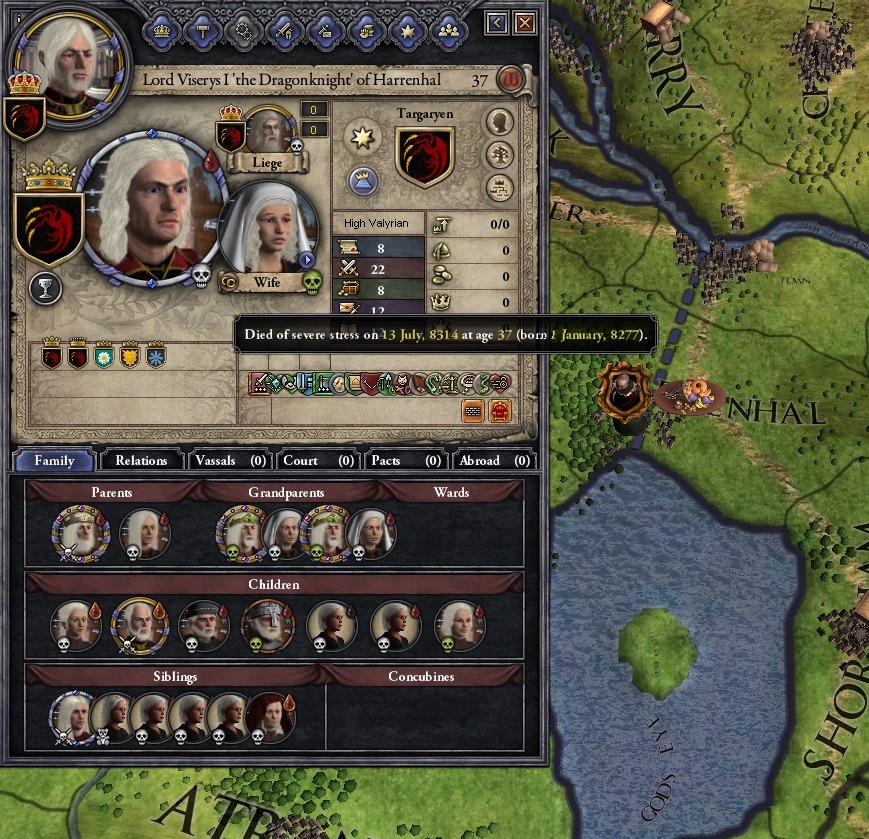
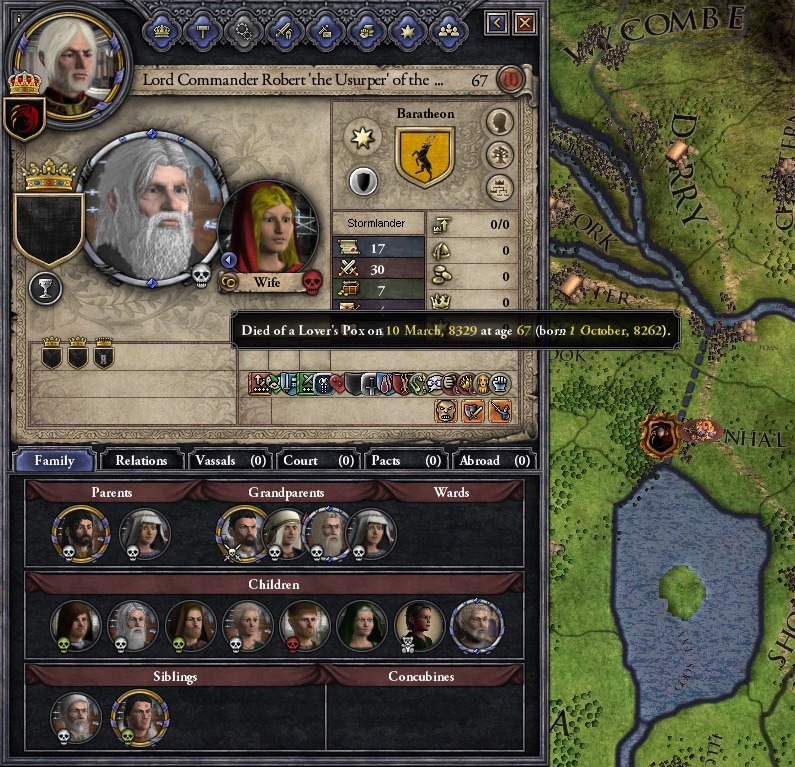
Just as these Targaryens rebuilt the ruins of Harren the Black, so too do we strive to rebuild these notable figures from tales of their exploits, accomplishments and downfalls.
Account the First, Viserys Targaryen of Harrenhal
It Began in a Ruin-
The Targaryen restoration started in a position of their greatest weakness, the young escaped prince and princess Viserys and Daenerys in custody of King Robert of House Baratheon (the events that led to this are murky, though we can estimate that they were either ransomed or recaptured from Essos). Yet this disturbance came at a greater unrest for Westeros, with a short-lived Ironborn uprising having taken place not long before and it is said that this recent bloodshed had slaked the Usurper’s appetite for further death and he showed an unprecedented mercy towards the Targaryen siblings.
The lesser threat of the child Daenerys was shipped to her own birthplace of Dragonstone, to be raised by King Robert’s brother (and likely to be wed into a loyal house or to the King’s own heir, Joffery).
The matter of Viserys however, must have been clear to those in King Robert’s court- such a threat to the Iron Throne must be sent to the Wall and live out his days without claim nor children. A harsh sentence to the young boy no doubt, but needless there would have been those who expected exile for the prince, if not outright execution.
But in a move that most likely saved King Robert from the executioner’s sword himself years on, the King granted Viserys high lordship over Harrenhall, as well as the empty seat itself. The reasons for this act are seen as follows
- An act of charity and amends for the murder of Elia Martell and the apparent deaths of her children
- A practical way to keep the Targaryen heir close to Kings Landing, while also filling the seat, as the previous lords- the Whents, had died out in the Ironborn uprising
- In order for Viserys to rule from a ruin, where focus and coin would be placed on making Harrenhal liveable, instead of attacks against the Throne
- Taking into account the legendary curse on Harrenhal that had already caused numerous noble houses to go extinct, fully expecting the Targaryen house to follow in a way that meant the King would not be directly responsible.
A Bold Knight, A Black Knight-
Despite being given Harrenhal, the young prince would not see it until he was grown, as King Robert would not foster him out but instead kept him in Kings Landing under the charge of the Kingsguard, and as the squire of the Lord Commander, Ser Barristan Selmy.
We leave the telling of the exploits of Ser Barristan to the true and detailed accounts, for his interactions with Viserys we cannot say were his greatest feats. But nevertheless, the result of having such a knight as a guardian for the last Targaryen can be felt for generations at Harrenhal. Whatever madness the prince had was soon tempered and from his sword work to his sense of justice Viserys was greatly shaped by the Lord Commander’s guidance and a great friendship grew between them.
This was to be soon tested, however, after the newly-knighted Viserys was at last at Harrenhal and undertaking his duties, including a bloody revenge. With many of the records expunged in the wake of the fall of House Baratheon, what we do know is that Viserys returned to Kings Landing soon enough, as a prisoner. The deaths of Ser Gregor Clegane and Ser Amery Lorch were rumoured as a sworn vengeance on the murderers of Viserys’ beloved older brother’s family. However this is disputed, the claim being it was a plot to murder the Lord Paramount Tywin Lannister that finally allowed King Robert’s Hand to attempt justice.
Having squired and been knighted by Ser Barristan, Prince Viserys was a cunning duelist and would no doubt win blades with any opponent during a Trial by Combat. But his opponent would have been Viserys’s own friend and mentor, Ser Barristan Selmy. With this terrible choice, the consequences being the fall of his own life and the Targaryen house, or the death of his greatest friend at his own steel, we can see the inspiration for the tale of The Bold Knight, the Black Knight.
Two versions of this story exist, with two different endings. The characters are the same with one based on Ser Barristan’s epithet of ’Bold’. As Viserys had not yet earned the nickname he would be known by, we can guess that his descriptor of ‘Black’ is in reference to either his place in the Black Cells, his seat build by Harren the Black or even the black stain of dishonour the tale refers to. Regardless, the more popular and sorrowful story ending has the two knights forced to fight despite being as close as father and son, where the Bold Knight slays the Black Knight and justice is meted out. The real events of the Trial That Never Was made for a less dramatic story ending, as Viserys was some time later returned to Harrenhal unscathed, having assumably organised a bargain or ransom with the coin he’d been repairing Harrenhal with. In the years following, we can add here, he would be joined by his younger sister (now grown and yet to be betrothed) whose visit may have allowed the subsequent war for the Iron Throne to include the force of Harrenhal.
The Return of the Dragon
In an event documented by much more thorough maesters, the return of Aegon the Restorer, son of Rhaegar and Elia to claim his rightful throne meant as much to his kin Viserys as it did to their foes. The then eighteen Aegon's claim was supported by Viserys and Daenerys and their current position as no longer hostages to King Robert allowed them to fight alongside their young nephew and at its end, they were there at Aegon's coronation. It is said this is where Prince Viserys, newly second in line to the Iron Throne, offered his beloved sister in marriage to their new king and the reign of the Targaryens King Aegon and Queen Daenerys began once more.
In this changeover, Viserys is referenced again in the Usurper Trials, where Robert Baratheon's mercy to Viserys and Daenerys meant he was not executed or exiled to Essos with his children but instead sent to the Wall where he rose to Lord Commander until his death at a great age. The numerous tales in praise of the fair new King do not mention Prince Viserys much, as he had returned to work on Harrenhal and gain the trust of his new Lord Paramount Edmure Tully as a Master-at-arms in Riverrun.
The Bower Bloom’d, a song ostensibly about Garth Greenhair (or even perhaps the Greenfield’s seat of the Bower) is more commonly linked to Aegon the Restorer and his four lovers- all natural-born daughters of prominent houses.
One such line references the four women’s bastard surnames:
“The King loved each river-stone, he loved each hill and flower
He raised them to his breast and lay them in his bower”
This is in reference to Joy Hill (Lannister), Mya Stone (Baratheon), Alys Flowers (Tyrell) and the famous Ravella Rivers (Frey). Furthermore, the storm which the song mentions the King keeping his ‘bower-bed warm’ from, speaks to Queen Daenerys, Aegon’s wife, called ’Stormborn’, who by all accounts was long-suffering of her husband’s roaming. The Targaryen King was frequently likened to his ancestor Aegon the Unworthy throughout his life, with Queen Daenerys akin to Queen Naerys and so her beloved brother was destined to be known by a glorious and infamous title.
The Dragonknight of Harrenhal
For each whisper that called Viserys 'Aemon the Dragonknight reborn', they fail to take into account the one person that Viserys was known to have loved more than his cherished sister- Talisa, the lady of Harrenhal from the Maegyr house of Volantis. It was she who upon winning his first grand tourney was crowed Viserys's Queen of Love and Beauty and only after her illness and sudden death did Viserys begin to crown his sister with the title instead (passing over his second wife Saenera Paenymion). The curse of Harrenhal had stuck not only Talisa but two of their infant sons and at the age of thirty-seven Viserys himself died. This was attributed to stress, as the loss of his much loved first wife and his friend Ser Barristan fed into Viserys's paranoia in his last years as he worked tirelessly to move the rubble of Harrenhal.


Last edited:



